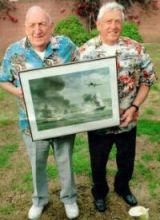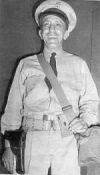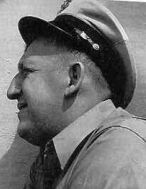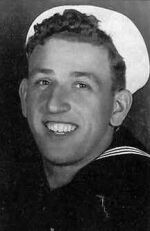 Sam Kronberger passed away-Date Unknown
Sam Kronberger passed away-Date Unknown
 Richard Kronberger passed away on Sept. 26th, 2003
Richard Kronberger passed away on Sept. 26th, 2003
 Edward M. Kronberger passed away on Aug. 7th, 2004
Edward M. Kronberger passed away on Aug. 7th, 2004
 Robert S. Kronberger passed away on Oct. 5th, 2006
Robert S. Kronberger passed away on Oct. 5th, 2006
"Gardena Valley News, December 11, 1941"
"Gardena's foremost naval family comprising of a father and four sons face the possibility today that the father and two of the sons may have lost their lives or been seriously injured on the Hawaiian Islands Sunday. The father, Sam Kronberger and two of the sons were stationed on the USS West Virginia reported sunk by the Japanese in Pearl Harbor. The two sons on the same ship were Edward and Robert Kronberger. Up to a late hour last night no word had been received by Mrs. Sam Kronberger or their daughter Dorothy concerning the fate of the three..."
It would be another two to three weeks before the stateside Kronbergers would find out that Sam, Robert & Edward did survive the events of Dec. 7. Nearly six decades later, Robert and Edward recall the surprise attack with such accuracy that Robert was consulted by Disney Studios as the script was prepared for the big budget movie "Pearl Harbor," which opens Memorial Day weekend. Along with their father, Robert and Edward helped found the Pearl Harbor Survivors Assn. in 1958. Robert stepped down as President of the Association last year.
The three men saw action across the Pacific throughout World War II. Sam had joined the Navy before World War I and retired in the late '40s. He passed away in 1961. Robert and Edward and two other sons attended high school in Southern California, where the family had moved in 1932, and all four joined the Navy. After the war, Robert served in the European occupation, the Korean War and Vietnam before retiring as a commander in 1970. Now 83, he lives in Big Bear City with his wife Marion. Edward retired from the Navy in 1960 as a boatswain's mate first class, then worked for two decades at the now-defunct Bethlehem Shipbuilding Corp. in Terminal Island. He is 81 and lives with his wife, Ruth, in Torrance.
Interview
Mark E. Harris: How were you spending the last moments of peace in Pearl Harbor?
Edward Kronberger: The day started off with me on mid-watch. That's 12 to 4 in the morning. I had a belt on with a billy club and walked the top side of the USS West Virginia [moored on Battleship Row with the Tennessee next to it and the Arizona in front of the Tennessee] doing security....checking for fires, making sure everything was all right.
Robert S. Kronberger: That night was real beautiful with a big moon out.
Mark: Did you have any inkling of what was about to happen? Did you feel that war was imminent?
Robert: Not at all. I was in a whorehouse...the New Senator Hotel...(laughing) on shore patrol. A ship with a thousand people would maybe send out 10 on shore patrol to keep the kids out of trouble... I came back to the ship about 6:30 in the morning on a milk boat.
Edward: We had been out to sea and came back in to Pearl on the 5th. We were out on fleet maneuvers, and we knew there were Japanese submarines in the area. We had live ammunition on all the topside guns just in case. I think the order was out: "If a periscope shows up, shoot it." That was the only thing.
Mark: What did you do when you got off your shifts?
Edward: I went down to the armory. We slept on cots there, but I decided not to rig mine up and just lay down and put my head under a locker to keep the light out of my eyes. I was supposed to go ashore around 8 o'clock with the old man for breakfast with some of his friends.
Robert: I went down to the fireroom and dropped down on the floor plates to sleep. About 45 minutes later they called away the fire and rescue party because they saw some smoke. They thought maybe it was a fire but it was the result of the first bombs the Japanese dropped. I stayed where I was because my fire and rescue station was in the boiler room, where I was. At Pearl harbor, I was a first class boilerman...a water tender in those days.
Mark: You wouldn't necessarily think a war had started because there had been an explosion or a fire?
Robert: We didn't think so, especially because we weren't at war. This was around 7:55. Almost immediately they passed the word "general quarters" [which meant that everyone had to report to their workstations]. Then we knew we were at war.
Mark: What was it like during those first moments when the bombs and torpedoes started coming in?
Robert: Mass confusion. People weren't ready for it. When the damn ship started shaking and blowing up and everything, we panicked a little bit. The ship started sinking. The lights went out. Nobody knew what was going on.
Edward: When we got hit by the first torpedo, my head went up and hit the bottom of the locker. I asked a fella: "What happened" and he said, "I think a ship rammed us." Then general quarters went. That was the start of it for me. We had no time to be scared. It's more scary when you know you're gong into battle the next day. When I got up, I went down starboard instead of going forward starboard and about 20 guys ran over me. On a ship you go forward starboard, down port. It's like a one-way street....I went the opposite way. I was going to my battle station, Turret Number 3, magazines. Magazines is where they store the ammunition. My job was to work in the powder room taking the powder sacks out of the powder cans and putting them through the scuttle. They were then sent up by a conveyer to fire the guns. I made it there and just stood there. I couldn't get in the magazines, they were locked. But who were we going to fire at anyway? We couldn't fire at airplanes from a 16 inch gun turret. It's a bombardment gun. We would have torn up half of Honolulu. [At least 40 US Navy shells and one Japanese bomb did rain down on Honolulu]. It was the biggest shell on any US warship.
Mark: Some of the most damaging weapons the Japanese had in their Pearl Harbor arsenal were 16 inch shells that they had converted into bombs.
Robert: They welded fins onto armor-piercing projectiles that you'd usually shoot out of the big guns to make bombs out of them. I think the one they dropped on the Arizona worked, the ones they dropped on the West Virginia and the Tennessee, which was next to us, just split open.
Edward: The bomb that hit the turret on the Tennessee didn't explode by the fragments flew over and killed our captain. [Capt. Mervyn S. Bennion]
Robert: The one on the West Virginia went through Number 3 turret. If that damn thing would have went up we would have been in the same shape as the Arizona. [The USS Arizona lost 1,177 men....more than 900 remain on board "buried at sea" in 35 to 40 feet of water underneath the Arizona Memorial in Pearl Harbor.] We took seven torpedoes along the port side of the ship. The first five hit below water line. Then after the ship sank there were two more torpedoes. They hit up on the third deck. I left the ship long before Ed did. I had no more business on a ship that had sunk. I was in the Number 8 fireroom, where you make the steam for propulsion and for generating electricity. The place was filling up with water and you couldn't see. I gave the order since I was the number one man in there: "Let's get the hell out of her!" We climbed a ladder. From the top side to the bottom of the ship was about six decks. We were 34 feet below the water line.
Mark: What did you see when you made it out on deck?
Robert: Hell! A lot of fire, smoke, and every other damn thing. People going all over the place, planes flying around. I saw one plane get hit and come down on the Curtiss. We were told to abandon ship. I jumped over the side into the water like the rest of them. We didn't have to jump far---the main deck was awash on the port side. I swam out there for a while. then a motor launch picked us up and dropped us off at Ford Island. Between the two attacks, I went over to the Naval Receiving Station and helped put sandbags and guns up there.
Edward: I think Pop jumped over the side as well because a kid named Cunningham who was on the Salt Lake City, where I ended up the following day, said: "I threw your father a heaving line and pulled him out of the water." We never talked too much about it. From December 8th until the end of the war, I was on the Salt Lake City, which was a heavy cruiser.
Mark: What time was the official abandon ship called?
Robert: I'd say just a couple of minutes after the whole thing started.
Edward: (laughing) I never heard it! A lot of the communications were gone. I left about an hour and a half after we hit the bottom of the ocean. They wouldn't let us leave. You were at your battle station, you stayed there. We were sitting on the bottom and had a port list [the ship was rolling to the left, which was corrected with counter-flooding that successfully righted it]. I heard a lot of people banging when we were on our way out of the turret.
Robert: We had three on the West Virginia who lived until just before Christmas. They kept marking on a calendar they had. The last mark was made on the 23rd of December. They were down in my area. They were down in the freshwater hold but they couldn't get out. They could hear them banging on things for weeks but there was no way to get to them.
Edward: The West Virginia got floated and put in dry-dock in June of 1942. that's when they found the men. [Seventy bodies were recovered during the salvage operation.] We eventually went up through the turret, which was hit during the bombing. I saw some pretty badly damage people in there. We went out to the main deck through a hatch on the bottom of the turret, then climbed on a line over to the Tennessee. By that time we got another strafing job and I jumped under Turret One on the Tennessee. I never saw any planes. I didn't want to stick my head out and get shot. I told this guy, I think his name was Lefler, that we had to get out of there, so we climbed over and got on the beach. We went to a bunch of officers' houses and me and him went in, got food out of the icebox and had a sandwich. there was a brand new US Navy Chevy station wagon parked outside with the keys in it, so we got in and went to the airfield to see what was happening over there. I stood around in a daze and watched what was happening, wondering what happened to my brother and my dad.
Mark: Robert, where did you end up after the initial attacks?
Robert. I went back to the West Virginia to fight the fire after the last raid around 10 in the morning and when I wasn't fighting the fire, I went down to the Number 8 fireroom on the Tennessee. They had their main engines on full speed because the burning sea and the heat from the Arizona were so tremendous that it was blowing up the compressed gas bottles and the gasoline tanks on the stern of the Tennessee. They kept their main engines running to keep that oil back. It was quite a day. I was frustrated. I was looking for my brother and my father. At one point around 10:30, I went over to the Arizona with a guy named Red Reed who worked with me.
Admiral Walter Stratton Anderson had told Comdr. Roscro H. Hillenkoetter, who was our acting captain because our captain was dead: "The Arizona is still a ship of the line. I want a flag on her." The Arizona had already sunk and was completely destroyed. Hillenkoetter turned to me and said: "Pick up another guy and take that flag over there." Red Reed and I went up the stern of the Arizona, took down the burnt flag, and put up a new one. It was no big deal, I didn't do anything heroic. I was just a guy doing his job, but it was the proudest moment of the war for me.
Mark: Was there any thought that a land invasion would follow or another wave of planes might be coming in?
Edward: We figured they were coming. There were rumors that paratroopers had landed.
Robert: Everyone thought they were coming. they flew over but didn't bomb the fuel tanks and they didn't do anything to the shipyard. We had brand new fuel dumps. If they would have gotten those, it really would have hurt us. If they were going to land, they'd want to save those.
Edward: In the evening some planes did come overhead. Lefler and I had stayed at the airfield most of the day and were sitting in the Chevy with our life jackets still on. Every gun opened up on them. [The planes turned out to be from the USS Enterprise and had gone out in search of the Japanese carriers. Unable to return to their carrier for a night landing, they were ordered on to Pearl Harbor to land at the airfield on Ford island. One plane and three pilots survived.]
Lefler said, "I'm getting out of here, Ed!" He left and I haven't seen him since. I jumped out of the station wagon and got under it. I woke up the next morning and realized I was right next to the gasoline storage area. That scared the hell out of me.
|

 Sam Kronberger passed away-Date Unknown
Sam Kronberger passed away-Date Unknown
 Richard Kronberger passed away on Sept. 26th, 2003
Richard Kronberger passed away on Sept. 26th, 2003
 Edward M. Kronberger passed away on Aug. 7th, 2004
Edward M. Kronberger passed away on Aug. 7th, 2004
 Robert S. Kronberger passed away on Oct. 5th, 2006
Robert S. Kronberger passed away on Oct. 5th, 2006


